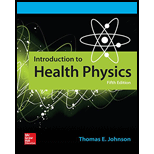
Concept explainers
A worker accidentally ingested an unknown amount of σUCo activity. His body burden was measured by whole-body counting from day 1 until day 14 after the ingestion, with the following results:

The whole-body intake retention fraction (IRF) for ingested 60Co is given as
(a) Estimate the amount of ingested activity
(b) What was the committed dose from the ingested radiocobalt?
(a)
The amount of ingested activity.
Answer to Problem 13.22P
Explanation of Solution
Given info:
The body burden was measured by whole-body counting from day 1 until day 14 after the ingestion with the following results
Day: 1, 2, 3, 4, 7, 14
kBq: 75.3 63.4 54.3 49.2 42.0 31
The whole-body retention function for ingested
Formula used:
The intake from a whole body measurement
Here,
Calculation:
So,
For 1 day, we have
Simlarly, intake from each of the whole body measurements
Thus mean,
(b)
What was the committed dose from the ingested radiocobalt?
Answer to Problem 13.22P
Explanation of Solution
Given info:
The body burden was measured by whole-body counting from day 1 until day 14 after the ingestion with the following results Day: 1, 2, 3, 4, 7, 14
kBq: 75.3 63.4 54.3 49.2 42.0 31
The whole-body retention function for ingested
Formula used:
The cumulated activity,
Substituting the values, we get
The dose is given by
Here,
Calculation:
So,
For 1 day, we have
Simlarly, intake from each of the whole body measurements
Thus mean,
Want to see more full solutions like this?
Chapter 13 Solutions
EBK INTRODUCTION TO HEALTH PHYSICS, FIF
Additional Science Textbook Solutions
Chemistry: Structure and Properties (2nd Edition)
Chemistry: An Introduction to General, Organic, and Biological Chemistry (13th Edition)
Fundamentals Of Thermodynamics
Introductory Chemistry (6th Edition)
Human Biology: Concepts and Current Issues (8th Edition)
Loose Leaf For Integrated Principles Of Zoology
- pls help on thesearrow_forward20. Two small conducting spheres are placed on top of insulating pads. The 3.7 × 10-10 C sphere is fixed whie the 3.0 × 107 C sphere, initially at rest, is free to move. The mass of each sphere is 0.09 kg. If the spheres are initially 0.10 m apart, how fast will the sphere be moving when they are 1.5 m apart?arrow_forwardpls help on allarrow_forward
- 19. Mount Everest, Earth's highest mountain above sea level, has a peak of 8849 m above sea level. Assume that sea level defines the height of Earth's surface. (re = 6.38 × 106 m, ME = 5.98 × 1024 kg, G = 6.67 × 10 -11 Nm²/kg²) a. Calculate the strength of Earth's gravitational field at a point at the peak of Mount Everest. b. What is the ratio of the strength of Earth's gravitational field at a point 644416m below the surface of the Earth to a point at the top of Mount Everest? C. A tourist watching the sunrise on top of Mount Everest observes a satellite orbiting Earth at an altitude 3580 km above his position. Determine the speed of the satellite.arrow_forwardpls help on allarrow_forwardpls help on allarrow_forward
- 6. As the distance between two charges decreases, the magnitude of the electric potential energy of the two-charge system: a) Always increases b) Always decreases c) Increases if the charges have the same sign, decreases if they have the opposite signs d) Increases if the charges have the opposite sign, decreases if they have the same sign 7. To analyze the motion of an elastic collision between two charged particles we use conservation of & a) Energy, Velocity b) Momentum, Force c) Mass, Momentum d) Energy, Momentum e) Kinetic Energy, Potential Energyarrow_forwardpls help on all asked questions kindlyarrow_forwardpls help on all asked questions kindlyarrow_forward
 College PhysicsPhysicsISBN:9781285737027Author:Raymond A. Serway, Chris VuillePublisher:Cengage Learning
College PhysicsPhysicsISBN:9781285737027Author:Raymond A. Serway, Chris VuillePublisher:Cengage Learning University Physics Volume 1PhysicsISBN:9781938168277Author:William Moebs, Samuel J. Ling, Jeff SannyPublisher:OpenStax - Rice University
University Physics Volume 1PhysicsISBN:9781938168277Author:William Moebs, Samuel J. Ling, Jeff SannyPublisher:OpenStax - Rice University College PhysicsPhysicsISBN:9781938168000Author:Paul Peter Urone, Roger HinrichsPublisher:OpenStax College
College PhysicsPhysicsISBN:9781938168000Author:Paul Peter Urone, Roger HinrichsPublisher:OpenStax College Physics for Scientists and Engineers: Foundations...PhysicsISBN:9781133939146Author:Katz, Debora M.Publisher:Cengage Learning
Physics for Scientists and Engineers: Foundations...PhysicsISBN:9781133939146Author:Katz, Debora M.Publisher:Cengage Learning Physics for Scientists and EngineersPhysicsISBN:9781337553278Author:Raymond A. Serway, John W. JewettPublisher:Cengage Learning
Physics for Scientists and EngineersPhysicsISBN:9781337553278Author:Raymond A. Serway, John W. JewettPublisher:Cengage Learning Physics for Scientists and Engineers with Modern ...PhysicsISBN:9781337553292Author:Raymond A. Serway, John W. JewettPublisher:Cengage Learning
Physics for Scientists and Engineers with Modern ...PhysicsISBN:9781337553292Author:Raymond A. Serway, John W. JewettPublisher:Cengage Learning





